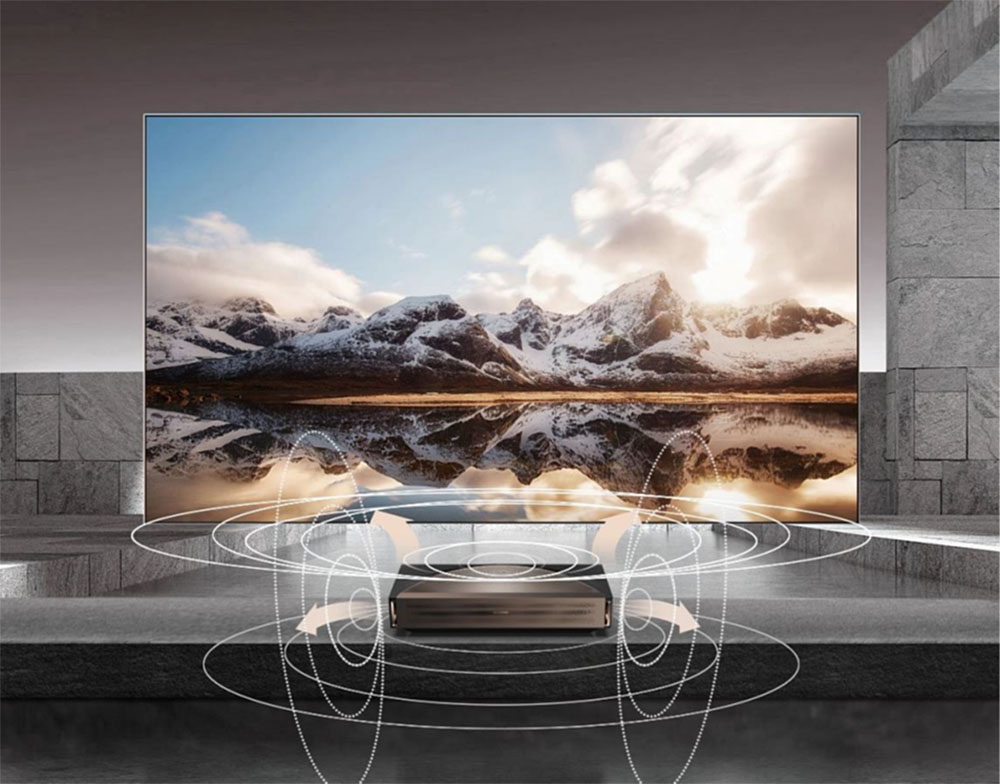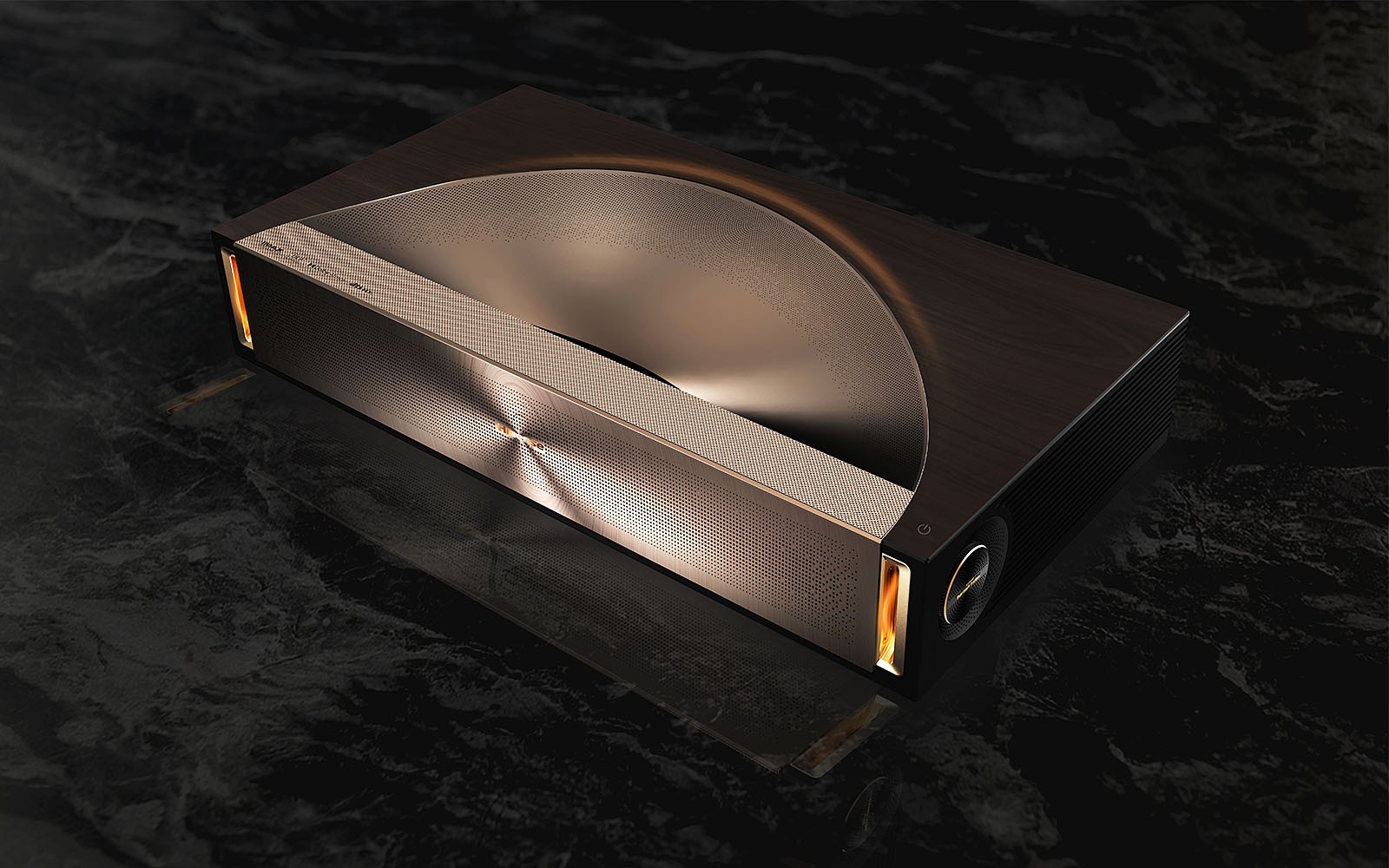The Chinese group is therefore taking advantage of the global media coverage of the CES 2025 show in Las Vegas to unveil the new flagship of its Laser TV range, the Hisense LQ9. Five technical screen sizes (see below) are announced: 100" (254 cm), 110" (279 cm), 120" (305 cm), 136" (345 cm) and 150" (381 cm). In France, the models with 100" and 120-inch technical screens will be distributed.
Laser TV, what is it?££££
As a reminder, with Laser TVs based on ultra-short throw video projector technology, a few dozen centimeters of distance are enough (around 40 cm) to obtain an XXL image (from 100'' and more). As their name suggests and like previous models, Laser TVs have a [abc]DVB-T[/abc]2, [abc]DVB-C[/abc] and [abc]DVB-S[/abc]2 tuner to enjoy [abc]TNT[/abc], cable or satellite channels. Similarly, the Hisense L9Q TriChroma Laser TVs are marketed with a specific screen (Fresnel type) whose particularity is to absorb ambient light to make way for the projected image.

Hisense L9Q Laser TV, new design££££
In 2025, the Hisense L9Q TriChroma Laser TV series sports a new aesthetic. Gone is the bio design with its soft curves, making way for a much straighter architecture with metal inserts and a sophisticated finish for a device whose size is similar to that of a 4K Ultra HD Blu-Ray player.
Hisense L9Q Laser TV, key video specifications££££
For the rest, the Hisense L9Q TriChroma Laser TVs benefit from [abc]HDR Dolby Vision[/abc] compatibility, a peak brightness of 5,000 lumens, a native contrast of 5,000:1 and 110% coverage of the Rec.2020 gamut (more or less what the human eye sees). Thus, with a 2.9 gain screen (like the one planned for the product demonstration at CES starting next Tuesday on the brand's stand), the peak brightness reaches 1,500 nits. Enough to watch any content or play on your console in broad daylight. Of course, the equipment remains the same with a triple [abc]RGB[/abc] laser but the projection ratio changes to 0.18. However, we do not yet have any details on the nature of the [abc]DMD[/abc] chip.
Hisense L9Q Laser TV, connectivity, connectivity and sound section££££
In terms of connectivity, among other things, there is an [abc]HDMI[/abc] 2.1 input, two HDMI 2.0, [abc]eARC[/abc] and [abc]ALLM[/abc] compatibilities and an [abc]Ethernet[/abc] port. Namely, the first named is announced as compatible with 4K/120 Hz by the brand, which would be good news. But this remains to be confirmed and it would be a first. Not forgetting the headphone jack, two antenna jacks and a [abc]CI+ port[/abc] compatible with [abc]Fransat[/abc]. In terms of connectivity, the [abc]Wi-Fi[/abc] 6E, [abc]Bluetooth[/abc] and the [abc]UPnP[/abc] ([abc]DLNA[/abc]) audio-video gateway function are all part of it.
Hisense L9Q Laser TV, the key audio specifications££££
To be precise, the 6.2.2 audio equipment of the Hisense L9Q TriChroma Laser TV delivers a total power of 116 watts (!). And the arrangement of the speakers, at 15° like for Roman amphitheaters, creates an enveloping 3D sound environment, especially considering the compatibilities [abc]Dolby Atmos[/abc] and DST Virtual X.

We also note the compatibility [abc]HBBTV[/abc], the PVR functions (recording on external [abc]HDD[/abc]) and [abc]Time Shifting[/abc], the management of the [abc]VP9[/abc] codec (in addition to [abc]HEVC[/abc]) and a [abc]Upscaling[/abc] UHD 4K of course. Finally, Hisense reminds us that its Laser TV L9Q displays an energy consumption 3.5x lower than that of a television of equivalent diagonal.
Hisense L9Q Laser TV, Google TV interface££££
Hisense's announcement of the L9Q Laser TV series is associated with the Google TV Smart TV function. This is a point to be confirmed later with the brand's French representatives given its history on the subject. Hisense prefers to highlight the Vidaa interface on its products in France. The same goes for voice assistants: if Alexa, Google Assistant and Siri are announced in the United States, what about France?
More details later.
Availability expected in the spring. Indicative prices: €6,500 for the Hisense 100L9Q and €7,500 for the Hisense 120L9Q.
UPDATE: the references distributed in France and their associated price have been added.
To not miss any of our publications, and to immediately learn about the latest news from the brands and manufacturers presented at the Las Vegas 2025 show, click on the following link: CES 2025, discover all the latest news live from Las Vegas
